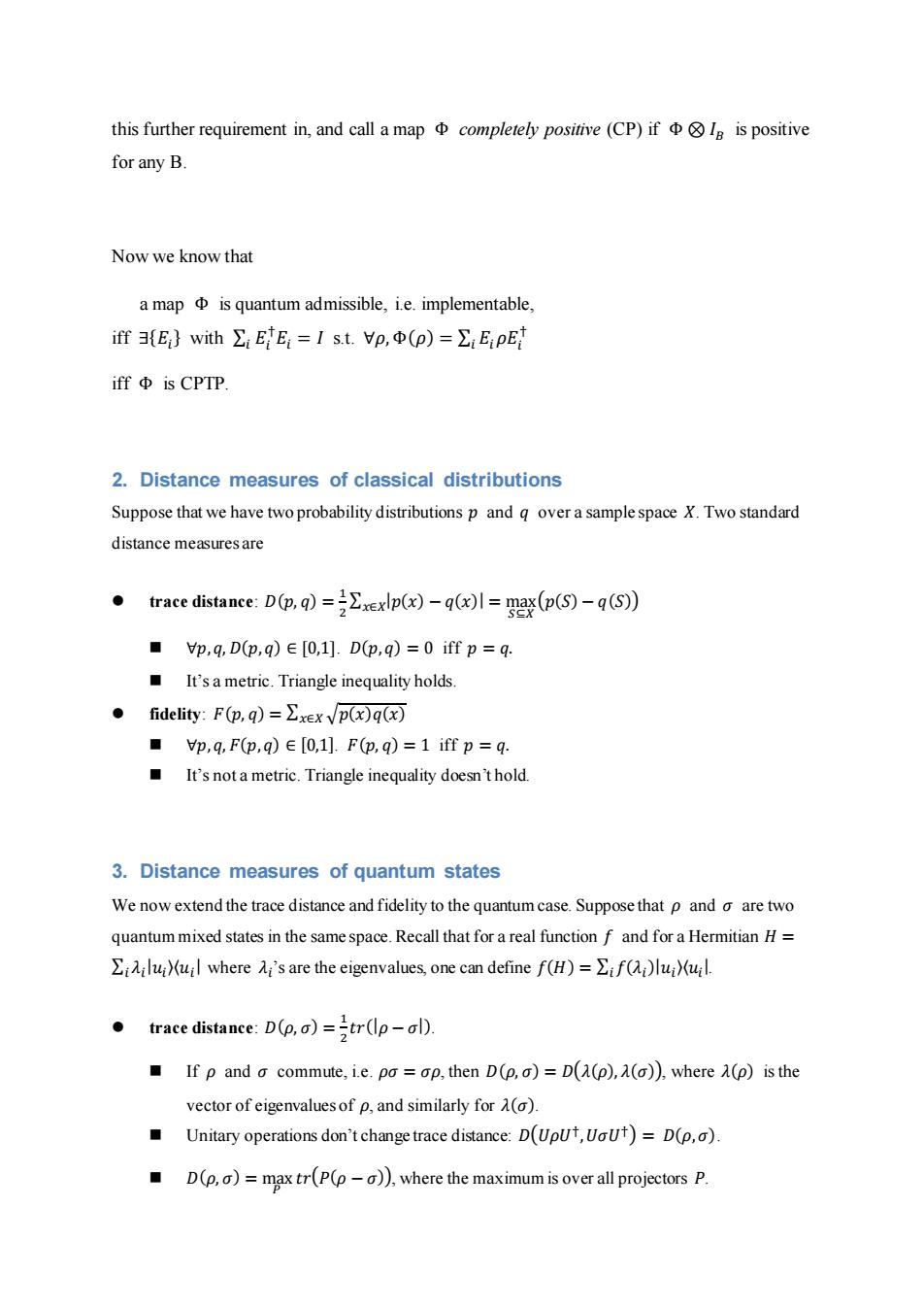正在加载图片...

this further requirement in,and call a map completely positive (CP)ifIg is positive for any B. Now we know that a map is quantum admissible,i.e.implementable, if{E}with∑EE:=Ist.Vp,Φ(p)=:EpE iffΦis CPTP. 2.Distance measures of classical distributions Suppose that we have two probability distributions p and q over a sample space X.Two standard distance measures are trace distance:D(p,q)=Exexlp(x)-q(x)I=max(p(S)-q(S)) ■p,q,D(p,q)∈[0,1].D(p,q)=0iffp=q. It's a metric.Triangle inequality holds. ●fidelity:F(p,q)=∑xex /p(x)qa ■p,q,F(p,q)∈[0,1].F(p,q)=1iffp=q. It's not a metric.Triangle inequality doesn't hold. 3.Distance measures of quantum states We now extend the trace distance and fidelity to the quantum case.Suppose that p and o are two quantum mixed states in the same space.Recall that for a real function f and for a Hermitian H= ul where 's are the eigenvalues,one can define f(H)=Eif(lui)uil. trace distance:D(p,a)=tr(lp-al). If p and a commute,i.e.po op,then D(p,)=D((p),())where (p)is the vector of eigenvalues of p,and similarly for A(). Unitary operations don't change trace distance:D(Uput,UoUt)=D(p,o) D(p,a)=max tr(P(p-a)),where the maximum is over all projectors P.this further requirement in, and call a map Φ completely positive (CP) if Φ ⊗ 𝐼𝐵 is positive for any B. Now we know that a map Φ is quantum admissible, i.e. implementable, iff ∃{𝐸𝑖 } with ∑ 𝐸𝑖 † 𝑖 𝐸𝑖 = 𝐼 s.t. ∀𝜌, Φ(𝜌) = ∑ 𝐸𝑖𝜌𝐸𝑖 † 𝑖 iff Φ is CPTP. 2. Distance measures of classical distributions Suppose that we have two probability distributions 𝑝 and 𝑞 over a sample space 𝑋. Two standard distance measures are ⚫ trace distance: 𝐷(𝑝, 𝑞) = 1 2 ∑ |𝑝(𝑥) − 𝑞(𝑥)| 𝑥∈𝑋 = max 𝑆⊆𝑋 (𝑝(𝑆) − 𝑞(𝑆)) ◼ ∀𝑝,𝑞, 𝐷(𝑝,𝑞) ∈ [0,1]. 𝐷(𝑝,𝑞) = 0 iff 𝑝 = 𝑞. ◼ It’s a metric. Triangle inequality holds. ⚫ fidelity: 𝐹(𝑝, 𝑞) = ∑ √𝑝(𝑥)𝑞(𝑥) 𝑥∈𝑋 ◼ ∀𝑝,𝑞, 𝐹(𝑝,𝑞) ∈ [0,1]. 𝐹(𝑝, 𝑞) = 1 iff 𝑝 = 𝑞. ◼ It’s not a metric. Triangle inequality doesn’t hold. 3. Distance measures of quantum states We now extend the trace distance and fidelity to the quantum case. Suppose that 𝜌 and 𝜎 are two quantum mixed states in the same space. Recall that for a real function 𝑓 and for a Hermitian 𝐻 = ∑ 𝜆𝑖 |𝑢𝑖 〉〈𝑢𝑖 | 𝑖 where 𝜆𝑖 ’s are the eigenvalues, one can define 𝑓(𝐻) = ∑ 𝑓(𝜆𝑖 )|𝑢𝑖 〉〈𝑢𝑖 | 𝑖 . ⚫ trace distance: 𝐷(𝜌, 𝜎) = 1 2 𝑡𝑟(|𝜌 − 𝜎|). ◼ If 𝜌 and 𝜎 commute, i.e. 𝜌𝜎 = 𝜎𝜌, then 𝐷(𝜌, 𝜎) = 𝐷(𝜆(𝜌), 𝜆(𝜎)), where 𝜆(𝜌) is the vector of eigenvalues of 𝜌, and similarly for 𝜆(𝜎). ◼ Unitary operations don’t change trace distance: 𝐷(𝑈𝜌𝑈† ,𝑈𝜎𝑈†) = 𝐷(𝜌,𝜎). ◼ 𝐷(𝜌, 𝜎) = max 𝑃 𝑡𝑟(𝑃(𝜌 − 𝜎)), where the maximum is over all projectors 𝑃